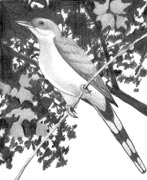|
 |
Earth Journal
by Gary Pendleton |
Yellow-Billed Cuckoo
Oh the  cuckoo she’s a pretty bird, cuckoo she’s a pretty bird,
And she warbles as she flies,
And she never hollers cuckoo,
’Til the fourth day of July.
—Clarence Ashley
The sounds made by the yellow-billed cuckoo, which is the most common of three species of cuckoo in the U.S., are more like cluckings than cooing. The song is a series of percussive notes, whose pacing becomes sluggish and labored at the end. To my ears, it sounds tropical and exotic. Along with the buzzing of annual cicadas and the recitations of the katydids, the song of the cuckoo signifies the humid days of high summer. It sounds something like this: kuk-kuk-kuk-kuk-kuk-kuk-koul-koul-kowwl-kowwllp.
I searched through all my field guides and bird books but could not find any reference to support Clarence Ashley’s claim as to the annual timing of the cuckoo’s maiden song. But the late Ashley was known more for his contributions to Appalachian-style music than to ornithology.
The name of both the cuckoo and the song credited to Ashley come from Europe. The European bird, which is associated with clocks and is related to the cuckoos of the Americas, does indeed say cuckoo. The folk song might be of Irish origin, or possibly Scottish, and is presumed to have been delivered to this country as a fiddle tune by Scotch-Irish immigrants in the mid 1700s.
Many of Scotch-Irish immigrants settled in the Appalachian Mountains. Over the centuries, the songs they brought with them evolved and became part of America’s cultural landscape. The version Ashley is credited with is considered a banjo tune; it contains a number of verses with bits and pieces from other traditional folk songs included somewhere along the line.
By the way, Ashley gets credit for his version of the song because, in addition to popularizing it, he submitted it for publication. I first heard it on an album recorded in the 1960s by folk singer Tom Rush.
Some folks know the yellow-billed cuckoo by the wonderful name of rain crow. The idea is that the song of the bird is an indication that rain is imminent. So don’t be surprised if, while out wandering on a summer afternoon when thunderheads are building in the sky, you hear the sound of a rain crow calling in the hazy, hot and humid July air.
|
